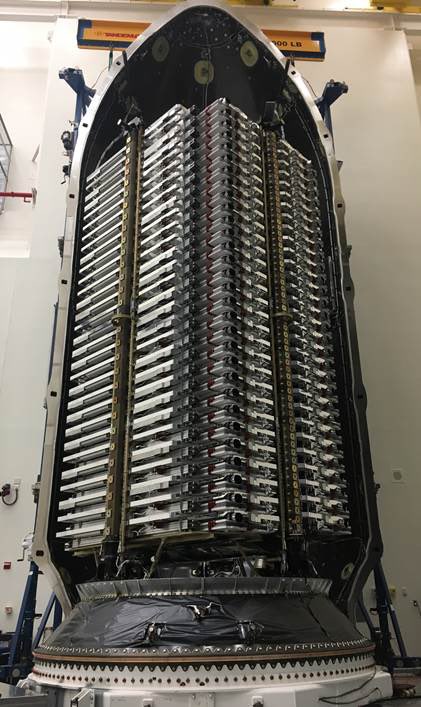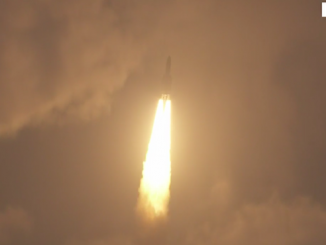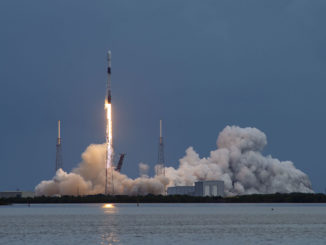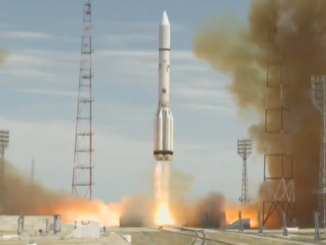
The 60 satellites SpaceX is set to launch Wednesday night, beginning the build-out of a broadband network of orbiting spacecraft that could eventually number thousands, are based on a new flat-panel design, with krypton-fueled plasma thrusters, high-power antennas, and a capability to autonomously steer away from other objects in space.
Each of the Starlink satellites weighs around 500 pounds (227 kilograms), according to SpaceX. Stacked together inside the payload shroud of a Falcon 9 rocket, the 60 satellites weigh 15 tons (13,620 kilograms), making the cargo on Wednesday night’s launch the heaviest ever lofted into orbit by SpaceX.
The new mass record bests the weight of SpaceX’s fully-fueled Crew Dragon spacecraft, which launched March 2 on an unpiloted test flight to the International Space Station.
In a press kit released early Wednesday, SpaceX disclosed new information about the Starlink satellites’ design and functionality. Each Starlink spacecraft has a flat-panel design with multiple high-throughput antennas and a single solar array, according to information released in the press kit.
The Starlink satellites carry Hall thrusters, which use electricity and krypton gas to generate an impulse, to maneuver in orbit, maintain altitude and guide the spacecraft back into the atmosphere at the end of their mission.
Hall thrusters provide a more fuel-efficient form of propulsion than conventional liquid propellants, but most satellites that use Hall thrusters consume xenon gas. Krypton is less expensive than xenon, but offers less thrust efficiency, according to a 2011 paper presented by U.S. Air Force and satellite industry engineers.
The satellites also host optical trackers to detect space debris, allowing the craft to autonomously avoid collisions with other objects in space.
Proposals by SpaceX and other would-be commercial broadband providers to launch thousands of new satellites into orbit have raised questions about traffic management. SpaceX originally intended to launch the first batch of Starlink satellites to a higher 741-mile-high (1,150-kilometer) orbit, but the company requested authority from the Federal Communications Commission last year to begin operating the network at a lower altitude.
The FCC approved the request last month.
SpaceX officials said the lower operating altitude for the first Starlink satellites will help assuage space debris concerns. If a Starlink relay station in the lower orbit fails, atmospheric drag will bring the satellite back to Earth within about five years.
“Additionally, 95 percent of all components of this design will quickly burn in Earth’s atmosphere at the end of each satellite’s life cycle — exceeding all current safety standards — with future iterative designs moving to complete disintegration,” SpaceX said in the press kit published early Wednesday.
The 229-foot-tall (70-meter) Falcon 9 rocket is set for liftoff from Cape Canaveral’s Complex 40 launch pad during a 90-minute window that opens at 10:30 p.m. EDT Wednesday (0230 GMT Thursday).
There is an 80 percent chance of good weather for liftoff during Wednesday night’s launch window, according to the U.S. Air Force’s 45th Weather Squadron. SpaceX plans to recover the Falcon 9’s first stage booster, which flew on two previous missions in September 2018 and in January, on the company’s drone ship a few hundred miles northeast of Cape Canaveral.
The mission will be SpaceX’s sixth launch of the year, and the 71st flight of a Falcon 9 rocket since 2010.
The 60 spacecraft packed on top of the Falcon 9 rocket for launch Wednesday introduce a new satellite design SpaceX intends to mass-produce at a factory in Redmond, Washington, to populate a fleet that could eventually number nearly 12,000 Internet relay nodes in low Earth orbit.
SpaceX has closely held details about the Starlink satellite layout, including basic information such as the number of spacecraft slated to fly on the company’s first rocket launch dedicated to the broadband network. Elon Musk, SpaceX’s founder and CEO, revealed in a tweet Saturday that 60 satellites will be aboard the Falcon 9 rocket when it takes off from Florida’s Space Coast.
Musk also tweeted a picture showing the 60 satellites stacked in launch configuration, ready for encapsulation inside the Falcon 9’s payload fairing.

SpaceX’s Starlink fleet is one of several commercial projects in development to beam Internet connectivity around the world. OneWeb launched the first six of its planned 648 satellites in February, with up to 100 more spacecraft scheduled for launch by early 2020.
And Amazon, backed by the fortune of billionaire Jeff Bezos, is looking to join the race to provide broadband services from satellite constellations.
SpaceX’s Starlink fleet is reportedly set to cost around $10 billion, with nearly 12,000 Ku-band, Ka-band and V-band satellites positioned in at different altitudes in multiple orbital planes. The first 1,584 Starlink satellites are slated to operate in orbits 341 miles (550 kilometers) above Earth, spread in 24 orbital planes inclined 53 degrees to the equator.
The Falcon 9 rocket launching Wednesday will begin deploying the 60 Starlink satellites around 62 minutes after liftoff. The launcher will target a 273-mile-high (440-kilometer) orbit for the separation sequence, and the satellites will activate their Hall-effect thrusters to raise their altitude to their 341-mile-high operating orbit.
SpaceX launched two Starlink demonstration satellites in February 2018 as piggyback payloads on a Falcon 9 launch from California. The spacecraft launching Wednesday have a different design, and are smaller than the testbeds launched last year.
“SpaceX designed Starlink to connect end users with low-latency, high-bandwidth broadband services by providing continual coverage around the world using a network of thousands of satellites in low Earth orbit,” SpaceX said in the press kit. “To manufacture and launch a constellation of such scale, SpaceX is using the same rapid iteration in design approach that led to the successes of Falcon 1, Falcon 9, Falcon Heavy, and Dragon.
“As such, Starlink’s simplified design is significantly more scalable and capable than its first experimental iteration,” SpaceX said.
“This mission will push the operational capabilities of the satellites to the limit,” SpaceX said. “SpaceX expects to encounter issues along the way, but our learnings here are key to developing an affordable and reliable broadband service in the future.”
Email the author.
Follow Stephen Clark on Twitter: @StephenClark1.



